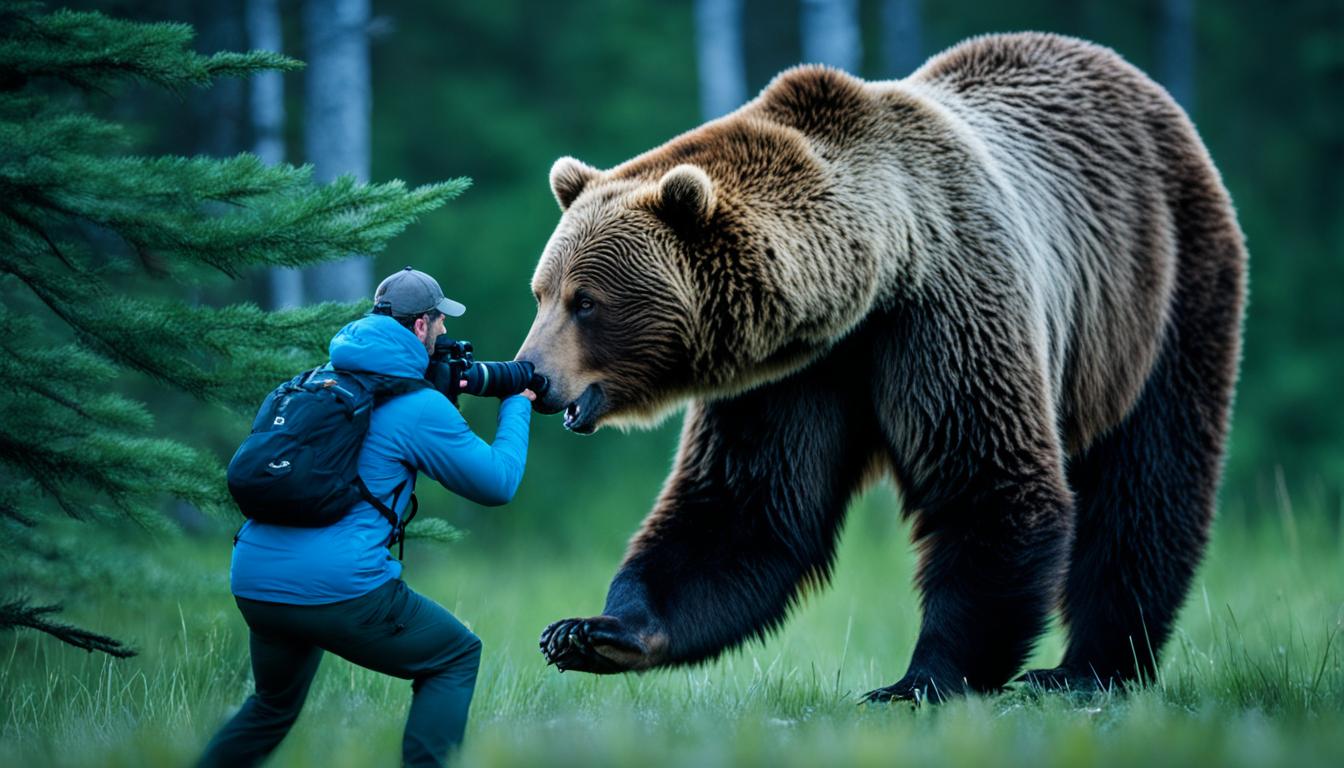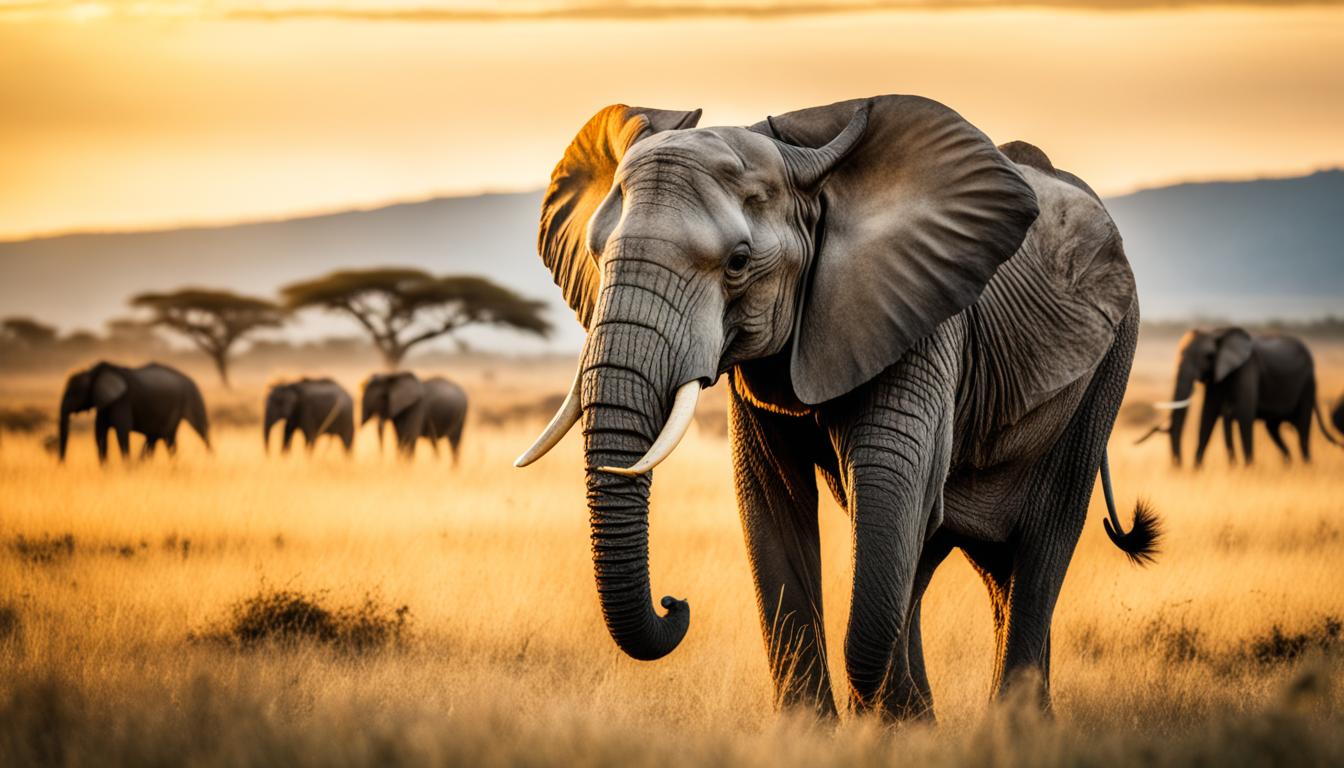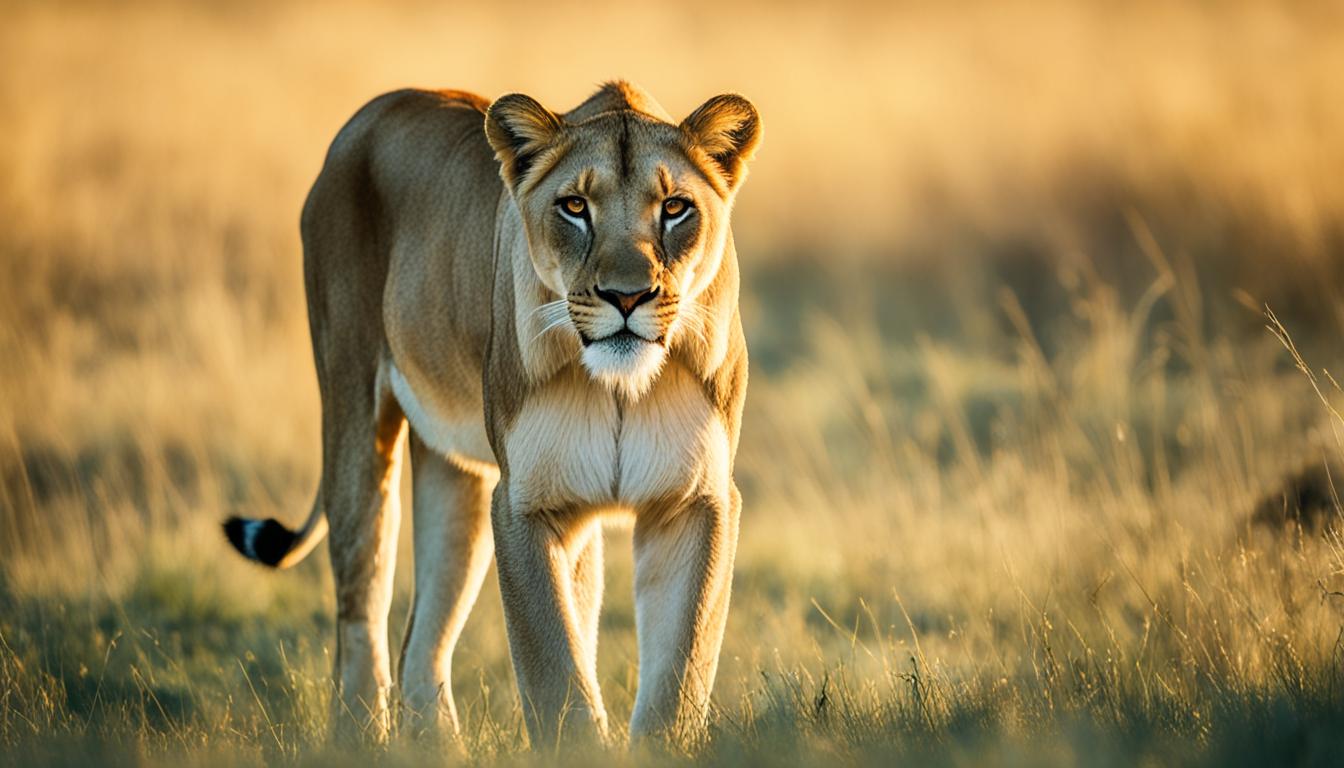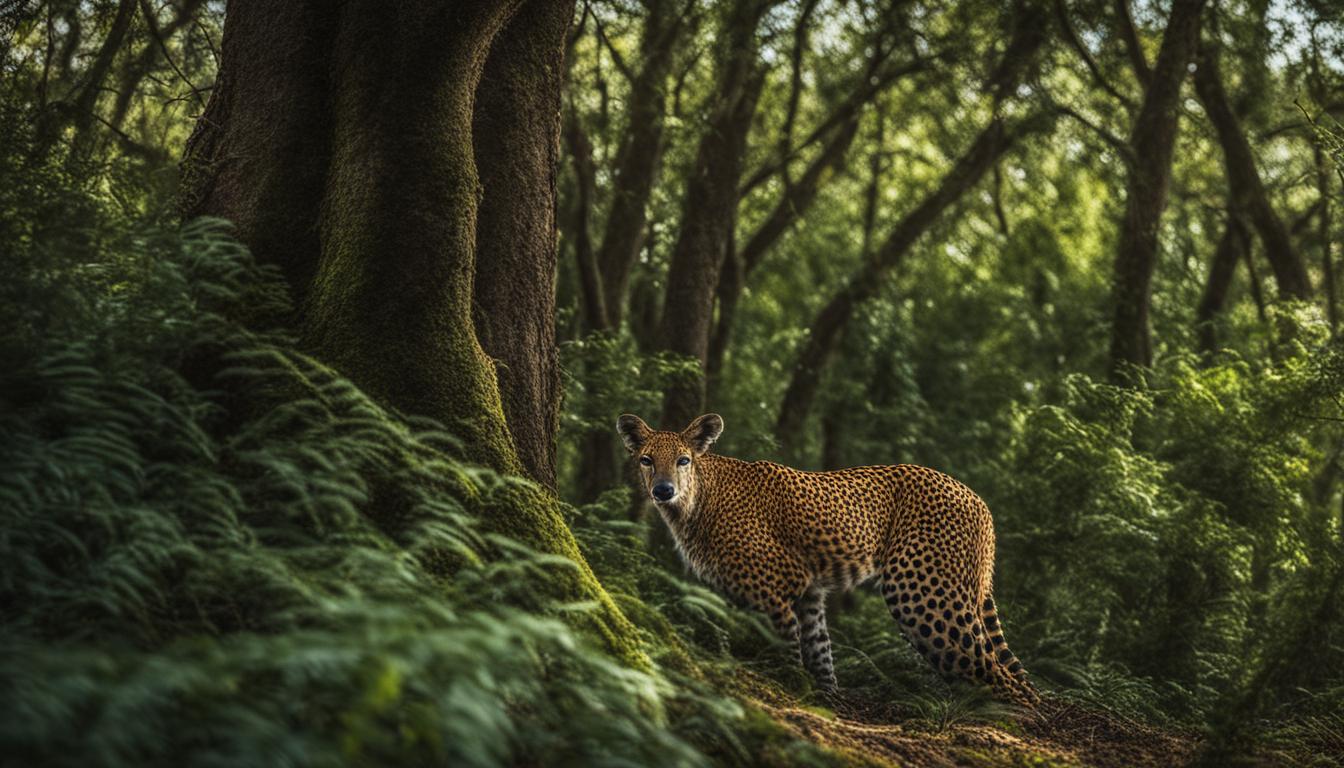Wildlife photography is an exhilarating experience that allows us to capture the beauty of nature and the fascinating behavior of animals. However, it’s crucial to prioritize safety, both for ourselves and the wildlife we encounter. By following these essential safety tips, we can ensure a successful and secure wildlife photography adventure.
Key Takeaways:
- Inform someone about your whereabouts before heading out for a wildlife photography expedition.
- Check the weather forecast and prepare accordingly to protect yourself and your equipment.
- Carry essential survival tools, a first aid kit, and sufficient food and water supplies.
- Research and educate yourself about the wildlife in the area to anticipate unexpected encounters.
- Dress appropriately with proper clothing and footwear suitable for the environment.
Tell Someone Where You Are Going
When embarking on a wildlife photography adventure, it’s crucial to prioritize your safety. One essential precaution is to always inform someone about your plans. Whether you are going alone or with a group, letting a trusted person know where you are going and when you expect to return can be a lifesaver in case of an emergency.
Why is it important?
Wilderness environments can be unpredictable, and accidents can happen. By sharing your itinerary with someone who will not be accompanying you, they can alert the authorities if you fail to return as planned. This precaution ensures that help can reach you quickly if you encounter any unexpected difficulties, such as getting lost or injured.
“Before heading out into the wilderness, always let someone know where you plan to go and when you expect to return.”
Remember to provide specific details about your intended location, including the name of the park or reserve, trail name, or any other relevant markers. If possible, share a map or GPS coordinates to help them pinpoint your exact location.
Additionally, establish a communication plan with the person you informed. Determine how frequently you will check in with them and the appropriate actions they should take if they don’t hear from you.
Check the Weather Forecast
When it comes to wildlife photography, being prepared is key to a successful and safe experience. Checking the weather forecast before you head out is essential to ensure you have the right gear and protection for the conditions you’ll be facing.
Knowing what weather conditions to expect allows you to make informed decisions about the equipment you bring and the precautions you take. It helps you dress appropriately, choose the right camera settings, and plan your shoot effectively.
We all know that the weather can be unpredictable, but with a little preparation, we can minimize the risks and maximize the opportunities.
Weather Apps and Websites
To stay updated on changing weather patterns, consider using reliable weather apps or websites. These tools provide real-time information, including temperature, wind speed, precipitation, and even storm warnings. Some popular options include:
- AccuWeather
- The Weather Channel
- Weather Underground
- Dark Sky
By using these resources, you’ll be able to plan your wildlife photography outings more effectively and stay safe in challenging weather conditions.
Protecting Your Gear
While some cameras and lenses are weather-sealed, it’s still important to take precautions to protect your gear from unexpected showers or extreme weather conditions. Investing in waterproof covers for your camera bag and a rain cover for your camera can provide an extra layer of protection against moisture.
| Equipment | Protection |
|---|---|
| Camera bag | Waterproof cover |
| Camera body and lens | Rain cover |
| Additional accessories | Waterproof cases |
By taking these simple precautions, you can minimize the risk of water damage to your valuable photography equipment and enjoy peace of mind during your wildlife photography adventures.
Carry Basic Survival Tools
When venturing into the wild to capture stunning wildlife photographs, it’s crucial to prepare for any unforeseen circumstances that may arise. In addition to having the right gear for photography, equipping yourself with basic survival tools is vital for your safety and well-being. These tools will help you navigate through challenging situations and ensure you are adequately prepared for emergencies.
Here are some essential survival tools that every wildlife photographer should consider carrying:
| Survival Tools | Use |
|---|---|
| Compass | Navigate and find your way back in unfamiliar terrain |
| Waterproof map | Assist with route planning and identifying nearby water sources |
| Satellite phone | Establish communication in remote areas with no cell service |
| Water purification tablets | Safely treat water from natural sources for drinking |
| Fire starter | Create warmth, cook food, and signal for help if needed |
| Knife | Perform various tasks, from cutting rope to preparing food |
Additionally, it’s essential to carry a basic first aid kit to tend to minor injuries quickly. Ensure your kit includes bandages, antiseptic ointment, pain relievers, and any necessary personal medications. Don’t forget to pack plenty of water and extra food supplies to sustain you in case of prolonged stays or unexpected circumstances.
These survival tools will not only help you be self-sufficient but also provide peace of mind knowing that you’re prepared for the unexpected. By prioritizing your safety and well-being, you can fully immerse yourself in capturing breathtaking wildlife photographs and create unforgettable experiences.
Expect the Unexpected
When it comes to wildlife photography, it’s essential to be prepared for the unexpected. While you may have a specific subject in mind, it’s important to remember that you may encounter other animals during your photography expedition. To ensure your safety and the well-being of the animals, it’s crucial to research the wildlife that inhabits the area you’ll be exploring.
For instance, if you’re planning to photograph in bear country, familiarize yourself with bear safety protocols and consider carrying bear spray as a precautionary measure. Knowing how to identify and respond to potential dangers, such as encounters with poisonous snakes, is also essential. This knowledge will give you confidence and help keep you safe in unforeseen circumstances.
“Being prepared for unexpected wildlife encounters will not only ensure your safety but also allow you to capture unique and fascinating moments.” – Wildlife Photographer
Remember, wildlife photography is about capturing the beauty and behavior of animals while respecting their habitat. By understanding the wildlife in your chosen location and taking necessary precautions, you can create stunning images while keeping yourself and the animals safe.
Precautions for Wildlife Photography
When photographing wildlife, it’s crucial to follow some best practices to ensure the safety of both yourself and the animals:
- Research the wildlife in the area and learn how to safely interact with them.
- Follow safety protocols specific to the animals you may encounter.
- Carry appropriate protective gear, such as bear spray or snake bite kits.
- Respect the animals’ personal space and avoid overcrowding them.
- Stay observant and aware of your surroundings at all times.
- Maintain a calm and non-threatening demeanor to minimize risks.
By following these wildlife photography precautions and best practices, you’ll be able to enjoy a safe and enriching experience while capturing stunning images of nature’s wonders.
| Precautions | Best Practices |
|---|---|
| Research the wildlife in the area | Follow safety protocols specific to the animals |
| Carry appropriate protective gear | Respect the animals’ personal space |
| Stay observant and aware | Maintain a calm and non-threatening demeanor |

Wear Proper Clothing
When it comes to wildlife photography, wearing the right clothing is essential for both your safety and comfort. Depending on the location and climate of your photography expedition, here are some key clothing considerations to keep in mind:
- Footwear: Opt for sturdy, comfortable shoes or boots that offer good traction. This will help you navigate varied terrains and protect your feet from potential hazards.
- Layered Clothing: Dress in layers to adapt to changing weather conditions throughout the day. This way, you can adjust your clothing as needed to stay warm or keep cool.
- Sun/Insect Protection: Protect yourself from the sun’s harmful rays by wearing a wide-brimmed hat, sunglasses, and applying sunscreen with a high SPF. In areas with insects, use insect repellent or wear clothing treated with insect repellent to prevent uncomfortable bites.
- Colder Environments: If you’re photographing wildlife in cold environments, consider wearing a balaclava or neck gaiter to protect your face and neck from frostbite. Additionally, microspikes can provide traction on icy surfaces.
- Warmer Climates: In warm climates, choose lightweight and breathable clothing that offers UV protection. Look for clothing with built-in insect repellent to ward off pesky bugs.
Remember to wear clothing that doesn’t make noise when you move to avoid alerting wildlife to your presence. The sound of rustling fabric or footsteps can startle animals and cause them to flee, missing out on capturing that perfect shot.
“Dressing appropriately for wildlife photography ensures our safety, comfort, and ability to focus on capturing incredible moments with minimal distractions.”
By keeping these clothing tips in mind, we can fully immerse ourselves in our wildlife photography experiences while staying safe and comfortable in any environment.
Provide Wildlife a Bit of Personal Space
Respecting the personal space of wildlife is essential for both their safety and ours. When photographing wildlife, it’s important to avoid overcrowding animals, as this can scare them away or make them feel threatened. Here are some wildlife photography best practices to ensure a respectful approach:
Use Long Lenses or Hides
If you don’t have a long lens to capture close-up shots, consider using a hide. A hide is a camouflaged structure or tent that allows you to observe and photograph wildlife from a safe distance without causing disturbance. By using a hide, you can create an unobtrusive environment that gives wildlife the space they need to feel comfortable while still getting the shots you desire.
For wildlife photography precautions, being able to photograph animals without interrupting their natural behavior is crucial. Hides provide the perfect solution, allowing you to get closer to the action without invading their personal space. Remember to set up your hide at a safe distance, considering the habits and comfort zone of the species you’re photographing.
Avoid Disturbing Wildlife
When approaching wildlife, it’s important to remember that they are not accustomed to human presence. Making sudden movements, producing loud noises, or disturbing their natural environment can lead to stress and potentially dangerous situations. It’s crucial to observe wildlife from a respectful distance and avoid any actions that could jeopardize their safety or compromise their well-being.
Capture Better Images While Ensuring Safety
By showing respect and giving wildlife the space they need, you’ll be able to capture better images that showcase their natural behaviors. Patience and understanding are key when photographing wildlife. By responsibly navigating their habitats and minimizing our presence, we can protect the animals and create stunning images of their natural beauty.

Be Mindful of Your Surroundings
When photographing wildlife, it’s crucial to always be aware of your surroundings. By paying attention to your environment as you move, you can identify potential risks and opportunities. Being mindful of your surroundings not only ensures your safety but also enables you to capture unique moments in wildlife photography.
Whether you’re exploring a dense forest or an open savannah, staying vigilant is essential. Scan the area for any signs of wildlife movement or behavior changes. Look out for potential hazards such as rocky terrain, slippery surfaces, or uneven ground that may lead to accidents.
Additionally, observe the weather conditions, as they can impact both your safety and the behavior of wildlife. Be aware of changes in wind direction and intensity that can affect how animals perceive your presence. Adjust your approach accordingly to minimize disturbances and maximize your chances of capturing stunning shots.
“In the end, the key to successful wildlife photography lies not only in technical skills and equipment but also in being present, aware, and respectful of the natural world around us.”
By being mindful of your surroundings, you can also take advantage of unexpected opportunities. Wildlife interactions are unpredictable, and being attentive allows you to adapt quickly and capture memorable shots. Whether it’s a rare species sighting or an extraordinary behavioral moment, being in tune with your surroundings gives you the best chance of seizing those magical photographic moments.
| Benefits of Being Mindful of Your Surroundings in Wildlife Photography |
|---|
| Enhanced safety for both the photographer and the wildlife |
| Improved anticipation of wildlife behavior and movement |
| Increased chances of capturing unique and extraordinary moments |
| Opportunity to adapt quickly to changing conditions |
Remember, wildlife photography is a beautiful way to capture the wonders of the natural world. By being mindful of your surroundings, you can ensure your safety, respect the animals you encounter, and create stunning images that tell a story.
Keep Low and Move Slowly
When photographing wildlife, it’s important to approach them with caution and respect. One of the key strategies for ensuring your safety and capturing incredible images is to keep a low profile and move slowly. This helps to minimize the chances of startling or alarming the animals, allowing for more natural behavior and reducing potential risks.
By maintaining a calm and non-threatening demeanor, you can create a sense of ease and trust with the wildlife you encounter. Here are some tips to help you stay safe while photographing wildlife:
- Stay low: Being at eye level or lower with the wildlife helps to establish a sense of non-threatening presence. This can be particularly effective when photographing animals such as deer or foxes.
- Move slowly: Sudden movements can startle animals, causing them to flee or become defensive. Instead, move slowly and deliberately, giving the animals time to acclimate to your presence.
- Avoid direct eye contact: Some animals perceive direct eye contact as a threat or challenge. To avoid any potential distress, avoid staring directly at the animals and maintain a relaxed gaze.
Remember, wildlife photography is a unique opportunity to observe and capture the beauty of nature. By respecting the animals and following these safety tips, you can enjoy this rewarding experience while ensuring the well-being of both yourself and the wildlife you encounter.
Be Prepared for Weather Changes
When it comes to wildlife photography, being prepared for weather changes is essential for your safety and the success of your photography endeavors. Weather conditions can change rapidly, so it’s important to stay ahead of the curve.
Carrying a lightweight poncho in your photography gear is a wise decision as it can protect both you and your equipment from unexpected rain showers. Additionally, don’t forget to pack sunscreen, a hat, and plenty of water to stay hydrated during your outdoor photography sessions.
Keeping an eye on the weather forecast is crucial. By staying informed about possible weather changes, you can adapt your plans accordingly and ensure your safety. Remember, being prepared for changing conditions will help you overcome any challenges and capture stunning wildlife photographs.
FAQ
What are some essential safety tips for wildlife photographers?
Wildlife photographers should prioritize safety for themselves and the animals they encounter. Here are some important safety tips to consider:
Why is it important to let someone know where you are going?
Before heading out into the wilderness, always inform someone about your planned destination and expected return time. This ensures your safety in case of any emergencies.
How can checking the weather forecast help with wildlife photography?
The weather can be unpredictable, so checking the forecast before your photography expedition helps you to prepare and protect your equipment. It’s important to invest in waterproof covers for your camera bag and rain cover for your camera.
What kind of survival tools should wildlife photographers carry?
In addition to photography gear, photographers should carry basic survival tools such as a compass, waterproof map, satellite phone, water purification tablets, fire starter, knife, first aid kit, water, and extra food supplies.
Why is it important to expect the unexpected when photographing wildlife?
While photographing wildlife, it’s important to anticipate encountering animals other than your intended subjects. Researching the animals in the area and learning how to safely interact with them can help ensure your safety.
How should wildlife photographers dress for their safety?
Wildlife photographers should dress appropriately for safety and comfort. This includes wearing proper footwear, layered clothing, sun/insect protection, balaclava and microspikes in cold environments, and clothing with built-in insect repellent and UV protection in warm climates.
Why is it important to provide wildlife with personal space?
Respecting the personal space of wildlife is crucial for their safety and yours. Avoid overcrowding animals, as it can scare them away or make them feel threatened. Consider using a hide to get closer to wildlife without disturbing them.
Why should wildlife photographers be mindful of their surroundings?
Being aware of your surroundings while photographing wildlife helps you stay safe and capture unique moments. Pay attention to potential risks or opportunities and remain vigilant at all times.
How should wildlife photographers approach animals in the wild?
When approaching wildlife, keep a low profile and move slowly to appear non-threatening. Avoid sudden movements and direct eye contact, as animals may perceive this as a threat. By acting calmly and respectfully, you can capture natural behavior while minimizing risks.
How should wildlife photographers be prepared for weather changes?
Weather conditions can change rapidly, so it’s important to carry a lightweight poncho, sunscreen, a hat, and plenty of water to stay hydrated. Keep an eye on the weather forecast and be ready to adapt to ensure your safety and the success of your photography endeavors.
How Can Wildlife Photographers Ensure Their Safety While Using Autofocus for Fast-Moving Wildlife?
Wildlife photographers can ensure their safety while capturing fast-moving wildlife by following some autofocus tips. Firstly, it is essential to choose a camera with a reliable autofocus system specifically designed for wildlife photography. Additionally, using continuous autofocus mode and selecting the appropriate autofocus point will increase accuracy and speed. Learning to anticipate animal behavior and shooting in burst mode can also enhance the chances of capturing that perfect shot. These fastmoving wildlife autofocus tips will not only improve the photographer’s safety but also enhance the overall photography experience.




